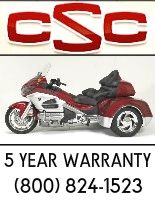I'm having a challenge with my 2010 SG Trike (SE air cleaner, cat-less header, slip-on mufflers, PCV tuner, TTS-100 cam, 60,000 miles on engine). The front cylinder will cut out when twisting the throttle wide open below 3,000 RPM ( like when trying to pass a vehicle) regardless of the gear I am in. However, it runs awesome when touring on flat roads, running at higher speeds, or banging through the gears just for the heck of it.
So here's what I have so far... The bike was doing this every now and then before I had the trike Dyno tuned and I figured it was either bad gas and/or in need of a tune (I was running the SE255 map on the TTS 100 cam until I had the time to get it Dyno tuned). After the tune it ran awesome! The Dyno really woke up the TTS cam!!!! However, the front cylinder was still cutting out from time to time (note: at this time I didn't know it was the front cylinder cutting out yet. We figured that out later)
I took it back to get it re-Dyno tuned and after a few runs without being able to duplicate it, the tech kicked it into 6th gear at a low RPM and rolled on the throttle and that would get the engine to run on just one cylinder every time. He double checked the air/fuel ratios and everything was coming up good so we were stumped as to what it might be. He then checked the fuel pump pressure and it was fine at all speeds, we disconnected the tuner and tried it with the stock ECM map and it did the same thing, he checked for any codes and the only one that showed up was one for an open purge valve (mine is a CA trike and I disconnected the purge system 55,000 miles ago). In a last resort effort he grabbed an old timing light and hooked it up to the front cylinder wire, ran the engine through it's paces, and whenever the engine cut out the timing light would not flash. We hooked it up to the rear wire and did the same test and the timing light flashed all the time, so we came to the conclusion that it was a bad front cylinder wire.
However, before I just go and replace the wires it still seems weird that the front cylinder wire cuts out ONLY when the engine is under a higher load (under 3,000 rpm... EXACTLY) and at 3/4 - full throttle. However, any kind of demands to the engine above 3,000RPM and it runs fine! It idles fine as well. About the only other issue I have with the engine is I think it kicks back too much when starting.
Is the solution really as simple as a bad wire, would a bad coil react this way under load, or could it be an even deeper issue? Any help would be greatly appreciated. Thanks
So here's what I have so far... The bike was doing this every now and then before I had the trike Dyno tuned and I figured it was either bad gas and/or in need of a tune (I was running the SE255 map on the TTS 100 cam until I had the time to get it Dyno tuned). After the tune it ran awesome! The Dyno really woke up the TTS cam!!!! However, the front cylinder was still cutting out from time to time (note: at this time I didn't know it was the front cylinder cutting out yet. We figured that out later)
I took it back to get it re-Dyno tuned and after a few runs without being able to duplicate it, the tech kicked it into 6th gear at a low RPM and rolled on the throttle and that would get the engine to run on just one cylinder every time. He double checked the air/fuel ratios and everything was coming up good so we were stumped as to what it might be. He then checked the fuel pump pressure and it was fine at all speeds, we disconnected the tuner and tried it with the stock ECM map and it did the same thing, he checked for any codes and the only one that showed up was one for an open purge valve (mine is a CA trike and I disconnected the purge system 55,000 miles ago). In a last resort effort he grabbed an old timing light and hooked it up to the front cylinder wire, ran the engine through it's paces, and whenever the engine cut out the timing light would not flash. We hooked it up to the rear wire and did the same test and the timing light flashed all the time, so we came to the conclusion that it was a bad front cylinder wire.
However, before I just go and replace the wires it still seems weird that the front cylinder wire cuts out ONLY when the engine is under a higher load (under 3,000 rpm... EXACTLY) and at 3/4 - full throttle. However, any kind of demands to the engine above 3,000RPM and it runs fine! It idles fine as well. About the only other issue I have with the engine is I think it kicks back too much when starting.
Is the solution really as simple as a bad wire, would a bad coil react this way under load, or could it be an even deeper issue? Any help would be greatly appreciated. Thanks






